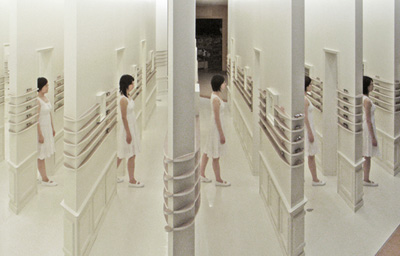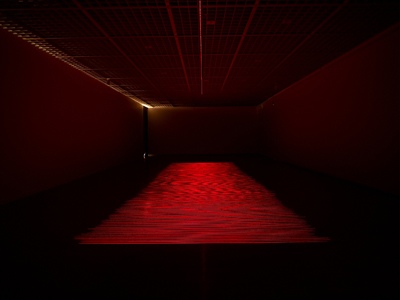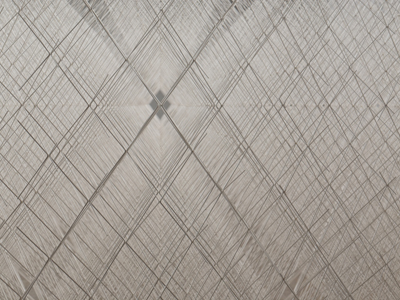Via Momat
---
This exhibition of architecture consists entirely of new installations by seven groups of Japanese architects, representing a variety of ages and styles.
To create "architecture," architects are expected to deal with a variety of conditions. This requires a way of thinking that deftly balances logic, technique, and aesthetics. One might also argue that this profound sense of balance is what has led to the international recognition of Japanese architecture. In trying to determine the special characteristics of "architecture," therefore, examining where and in what form it arises seems more viable than simply addressing the question, "What is architecture?"
In this wide-ranging group of installations, including a space created out of three types of polyhedrons, a place where a "space" is "born and dies," a summer house that resembles an animal, a video space that presents a day in the life of an architectural model, a fragile structure, and a field with a fantastic sense of scale, we invite the viewer to search for the architecture.
«Cornfield / Nakamura Riyuji"




Hideyuki Nakayama

About artists:
ITO Toyo (b. 1941- )
 |

The New Deichman Main Library Competition in Oslo, Norway, 2008-2009
Image: Kuramochi + Oguma
|
|
The spatial structure that Ito Toyo proposed for the New Deichmann Main Library Competition in Oslo, Norway in 2009 is a dynamic work that makes use of three types of polyhedrons to fill and develop the entire space. Ito's installation in this exhibition will make use of this system. And with a "wandering" display of the architect's recent projects, such as Za-Koenji, the Taichung Metropolitan Opera House, and the UC Berkeley Art Museum and Pacific Film Archive, the act of viewing is sure to take on a whole new air.
Biography
Born in 1941. 1965 Graduated from The University of Tokyo, Department of Architecture. Worked at Kiyonori Kikutake Architects and Associates. 1971 Started his own studio, Urban Robot (URBOT) in Tokyo. 1979 Changed its name to Toyo Ito & Associates, Architects. 2005- Commissioner of Kumamoto Artpolis (KAP).
inside in, 2010
Photo: Ano Daici
© Toyo Ito & Associates, Architects
NAITO Hiroshi (1950- )
 |

Makino Museum of Plants and People, 1999
© Naito Architect & Associates
|
|
Naito's work in this exhibition will consist of approximately 200 red lasers. Though immaterial, when someone enters the "space," it will take on a realistic aspect in this promisingly fantastic work. Moreover, taking inspiration from the work, JunJun SCIENCE and Umeda Hiroaki are scheduled to dance several times inside the installation during the exhibition period.
Biography
Born in 1950. 1976 Graduated from Graduate School of Waseda University, Master of Architecture. 1976-78 Worked at Architectural Office of Fernand Higueras. 1979-81 Worked at Kiyonori Kikutake Architects and Associates. 1981 Established Naito Architect & Associates. 2001-02 Associate Professor of School of Engineering, The University of Tokyo. 2003- Professor of School of Engineering, The University of Tokyo.
Red Stripes, 2010
Photo: Ano Daici
Dance: JunJun SCIENCE
© Naito Architect & Associates
Atelier Bow-Wow (TSUKAMOTO Yoshiharu, b.1965 and KAIJIMA Momoyo, b. 1969)
 |

Life Tunnel, (Psycho Building, Hayward Gallery, London) 2008
Photo: Atelier Bow-Wow
© Atelier Bow-Wow
|
|
Atelier Bow-Wow has participated in exhibitions all over the world. All of these works were created according to the "micro public space" concept. For this exhibition, the architects will produce an installation for the museum's front lawn titled "Rendez-vous." The work will make use of an animal motif, bamboo as a material, and will function as a summer house. Though the space in front of the museum has always been confusing — Is it an outdoor display of sculpture? Is it okay to go inside it? —, as the entire area will be redesigned through this installation, a variety of spontaneous acts are anticipated.
Biography
Atelier Bow-Wow: Established by Tsukamoto Yoshiharu and Kaijima Momoyo in 1992.
TSUKAMOTO Yoshiharu: Born in 1965. 1987 Graduated from Tokyo Institute of Technology. 1987-88 Guest Student of L'ecole d'architecture, Paris, Bellville (U.P.8). 1994 Graduated from Post-graduate school of Tokyo Institute of Technology, Doctor of Engineering. 2000- Associate Professor of Tokyo Institute of Technology. 2003, 2007 Visiting Faculty of Harvard GSD. 2007, 2008 Visiting Associate Professor of UCLA.
KAIJIMA Momoyo: Born in 1969. 1991 Graduated from Japan Women's University. 1994 Graduated from Graduate school of Tokyo Institute of Technology, Master of Engineering. 1996-97 Guest student of ETHZ. 2000 Graduated from Post-graduate school of Tokyo Institute of Technology, Doctor of Engineering. 2000- Assistant professor of University of Tsukuba. 2003 Visiting Faculty of Harvard GSD. 2005-07 ETHZ Guest Professor. 2009- Associate professor of University of Tsukuba.
Rendez-vous, 2010
Photo: Ano Daici
© Atelier Bow-Wow
NAKAMURA Ryuji (1972- )
 |

shortcut, 2007
Photo: Nakamura Ryuji
© ryuji nakamura architects co.,ltd.
|

kuma, 2006
Photo: Nakamura Ryuji
© ryuji nakamura architects co.,ltd.
|
After stacking up some corrugated panels, creating a beehive-like form, and boring holes in the resultant truss-like structure, an exterior will be added to the entire work, which will allow the viewer to verify how they "see." Then, by applying the "hechima" concept, Nakamura plans to create a huge "structure-like object," which though hollow and fragile, will be huge. How will the object make us feel? Not only will the structure be interesting, but the fact that our senses will be affected by the work is sure to be interesting.
Biography
Born in 1972. 1999 Completed the Master Course in Architecture and Planning, Graduate School of Fine Arts, Tokyo National University of Fine Arts and Music. 2000-2003 Worked at Jun Aoki & Associates. 2004 Established Ryuji Nakamura Architects.
cornfield, 2010
Photo: Ano Daici
© ryuji nakamura architects co.,ltd.
NAKAYAMA Hideyuki (1972- )

Photo: TAKASHI KATO
|

Door on the Prairie, 2009
Photo: Okamoto Mitsuo
© Hideyuki Nakayama Architecture
|
|
Nakayama's installation will be based on "Door on the Prairie," a proposal the architect submitted for the "Tea House Competition. " How would a "large door" look if it was reduced to a third of its original size? And what sort of sensation will we have when we look at it? The viewer will experience the gentle rewriting of the relationship between space and body.
Biography
Born in 1972. 2000 Completed the Master Course in Architecture and Planning, Graduate School of Fine Arts, Tokyo National University of Fine Arts and Music. 2000-07 Worked at Toyo Ito & Associates, Architects. 2007 Established Hideyuki Nakayama Architecture.
Door on the Prairie, 2010
Photo: Ano Daici
© Hideyuki Nakayama Architecture


























